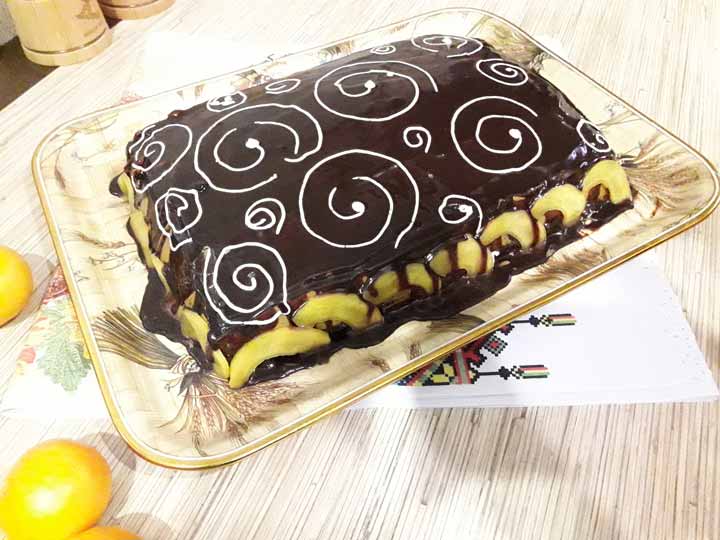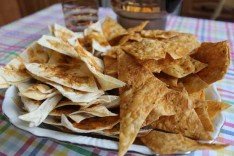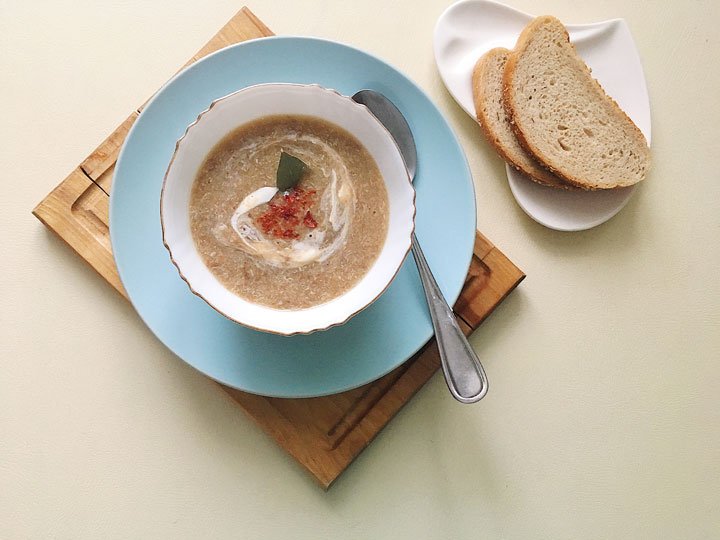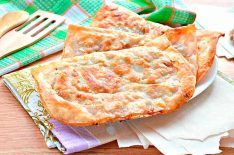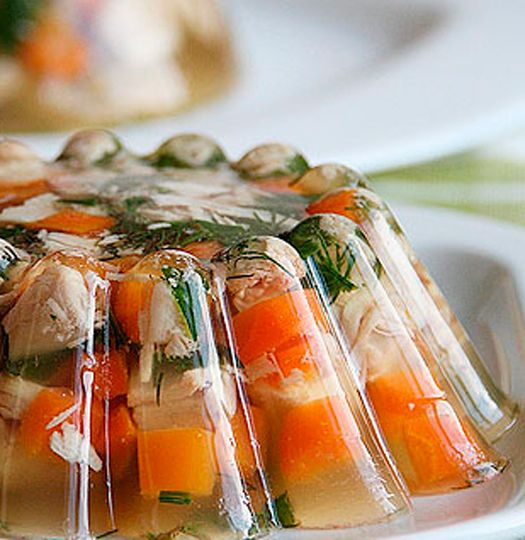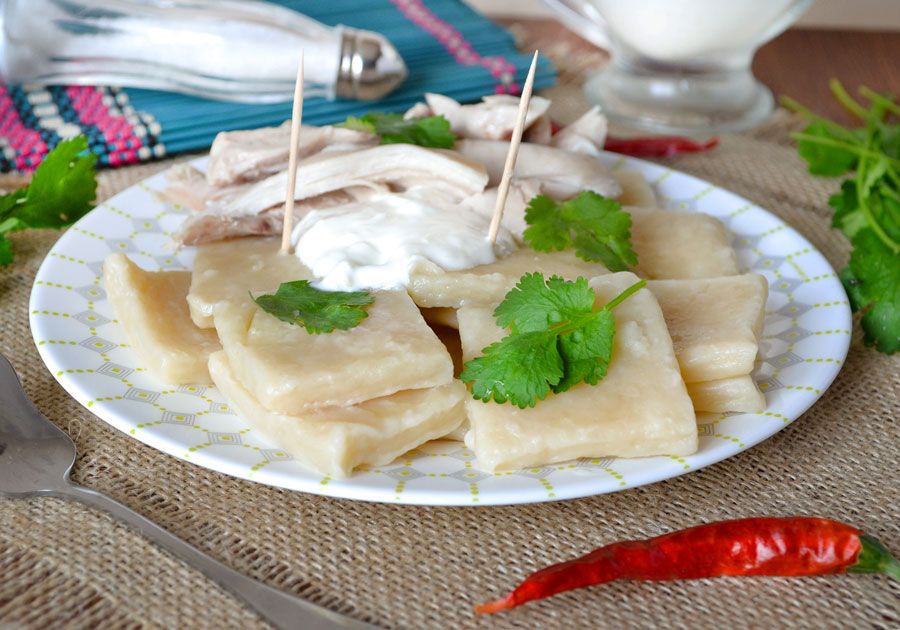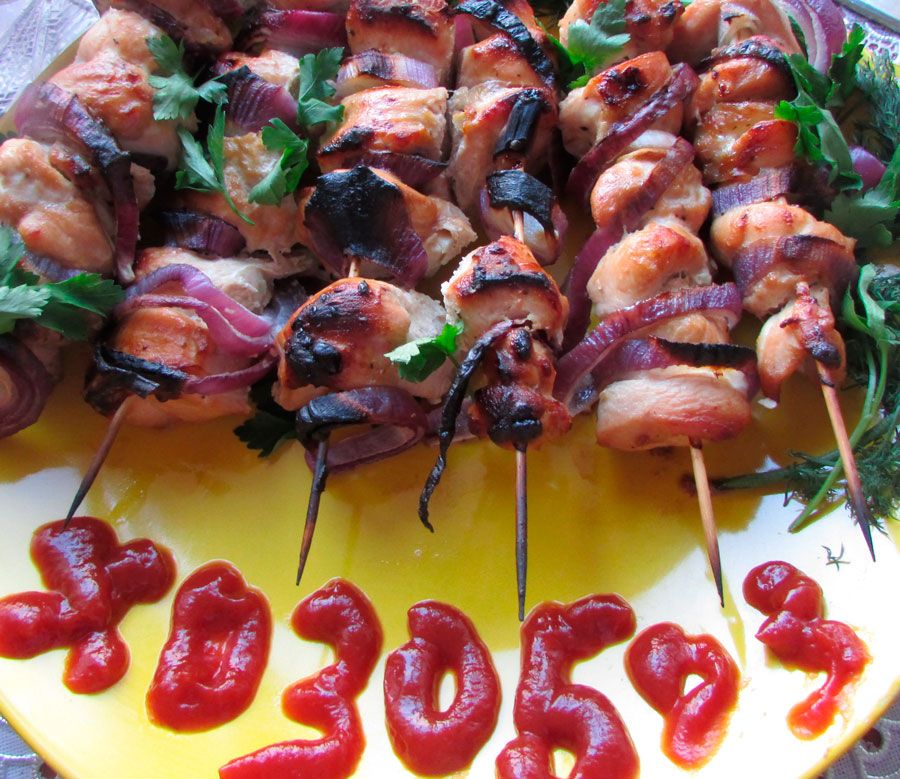Cheesecakes with cottage cheese
- Nutrition Facts
- Calories: 351
- Protein: 10
- Fats: 12.1
- Carbohydrates: 48.1
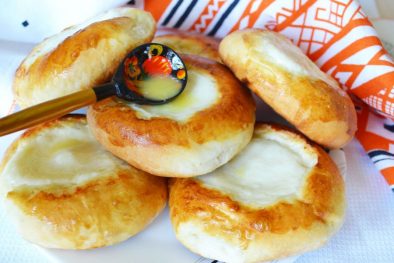
The work of a baker has long been valued above all other artisan professions, because in order to knead good dough, from which you can make a lot of different products, including bread, of course, you need to have great physical health, excellent sense of smell, diligence and many, many more, including well-developed sense of timing. However, in Russia, all women, young and old, knew how to cook various flour delicacies from dough kneaded with their own hands, and the whole family, and especially its female half, was connected at once to cooking, for example, pies. In families with a large number of small children, a place of honor has always been given to sweet open pies with various centers. Of these, of course, cheesecakes with cottage cheese or cheese, as it was then called, stood out.
History of cheesecakes
The most revered food product among the Slavic peoples, of course, was cottage cheese. In the diet, he occupied a leading position compared to the rest of the food. However, as you know, cottage cheese was not subject to long-term storage, this moment was taken into account by home cooks and tried with all their might to apply it somewhere. Flour was also in abundance, however, it was stored many times better. It turns out that flour and cottage cheese are in abundance, and as a result - pies with cottage cheese. Apparently, this is how open cheesecakes with cottage cheese appeared. Among the Slavs, the word vatra (from which the cheesecake originated) meant nothing more than “fire” or “hearth”. But, really, if you look at a rosy cheesecake, having a little fantasy, it resembles the sun, especially a large, idle, royal cheesecake with cottage cheese, which managed to saturate all the kids at once. Modern housewives often choose recipes where the finished pastries are small in size - this is more convenient. We offer you to plunge into Russian cuisine and cook convenient sweet cheesecakes that will certainly appeal not only to your children, if any, of course, but also to all other family members. Sweet cheesecakes with cottage cheese - a recipe for cooking.
Ingredients:
for the test:
- Boiled water - 2 tbsp. spoons;
- Fast-acting yeast - 1 pack (11g);
- Milk 2/5% fat - 1/3 tbsp.;
- Flour - 2-3 tbsp.;
- Yolk - 1 piece;
- Salt and sugar - 0.5 tsp each;
- Vegetable oil - 3 tbsp. spoons.
for curd filling:
- Fat village cottage cheese - 230 g;
- Egg squirrel - 1 piece;
- Regular sugar - 2/3 tbsp.;
- Vanilla sugar - to the taste of the hostess.
Additional components (for lubrication):
- Vegetable oil;
- Ghee or butter;
- Egg yolk.
How to cook cheesecakes with cottage cheese
- First of all, you need to knead the yeast dough and, of course, dissolve the yeast to begin with - it doesn’t even matter here whether they are fresh from a pack or dry, fast-acting from a bag. Yeast is an excellent baking powder for dough, and without it, alas, cheesecakes will never turn out lush and tasty, so we will definitely use them, placing them in an empty bowl first.

For the dough, put the yeast in a bowl.
- We breed "worms" in warm water (no more than 40 ° C), slightly mixing.

Dissolve the yeast in warm water.
- We add milk, also in a warm form. But take note - hot liquid will kill the fermentation process and your dough is unlikely to rise as it should.

Now add warm but not hot milk.
- Next, add the sifted flour, and if you are interested, we will briefly tell you why the flour began to be passed through a sieve: "In ancient times, baking from wholemeal flour was considered of low quality, and, indeed, it looked much different from flour products baked from sifted flour - hence the result.

Sift the flour through a sieve.
- Mix part of the flour with the preliminary components - this mixture is called dough. We leave it warm for about 1.5 hours for fermentation.
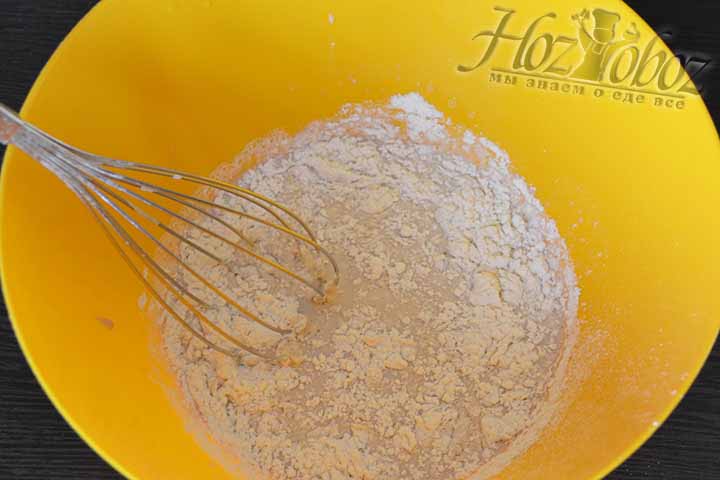
Pour part of the sifted flour into the dough blank.
- Readiness is determined by air bubbles and an increased volume of the mixture.

Let the dough stand for a while and ferment until bubbles appear.
- Mix in the egg yolk.

Add the egg yolk.
- Salt and sugar.
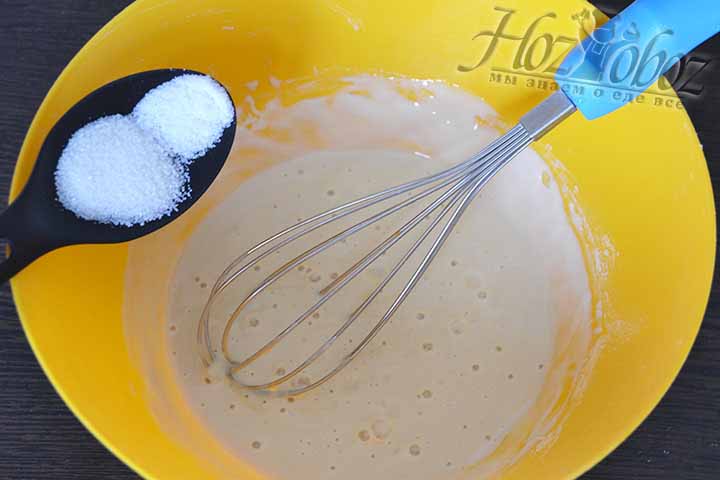
Now the dough must be salted and pour sugar into it.
- Then we add the remaining flour, but so that the dough does not turn out to be too liquid, because in the process of kneading we still need to pour in the vegetable oil.
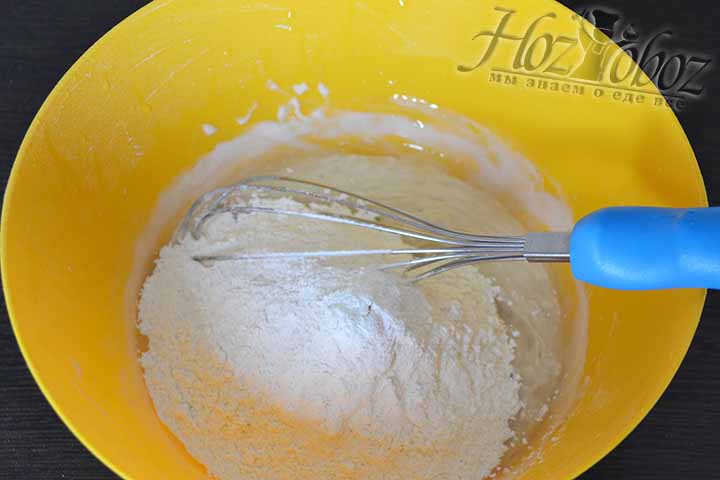
Then add the rest of the flour and vegetable oil so that the dough is not too thin.
- With the help of hands, knead the dough well and leave it in the same way as the dough, in a warm place for further fermentation.

Knead the dough by hand and let it rise for about 1 hour.
- Slightly enlarged dough - this is not quite ready-to-cut dough. We are waiting for a good rise, but we try not to miss the spontaneous punching - when the dough falls off on its own.

As soon as the dough has risen a little, it should be kneaded and let it rise again.
- While the fermentation process is being completed, we have a great opportunity to do the curd filling. It needs to be prepared quickly and immediately put into action, because the cottage cheese begins to give up moisture faster than you want. We put the product in a container.

While the dough rises for the second time, let's deal with the filling.
- Add the remaining protein from the whole egg. True, it's great when you get waste-free production, right?
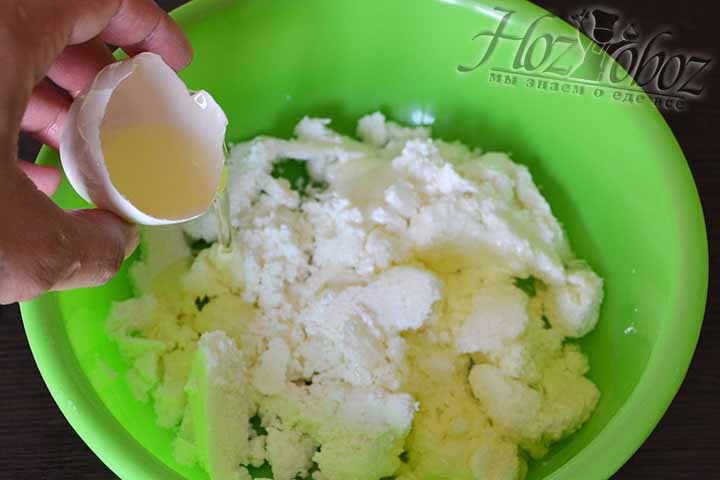
Add egg white to cottage cheese.
- Next, granulated sugar.

Add sugar.
- Mix quickly.

Mix everything thoroughly.
- A little flour is then added to keep the filling from spreading over the baking sheet, and here many cookbooks recommend adding it while fried, but we recommend leaving it as it is. Well, we don’t want to have a “rusty” center in color at the output.

We introduce flour into the filling.
- We complete the preparation with vanilla sugar.
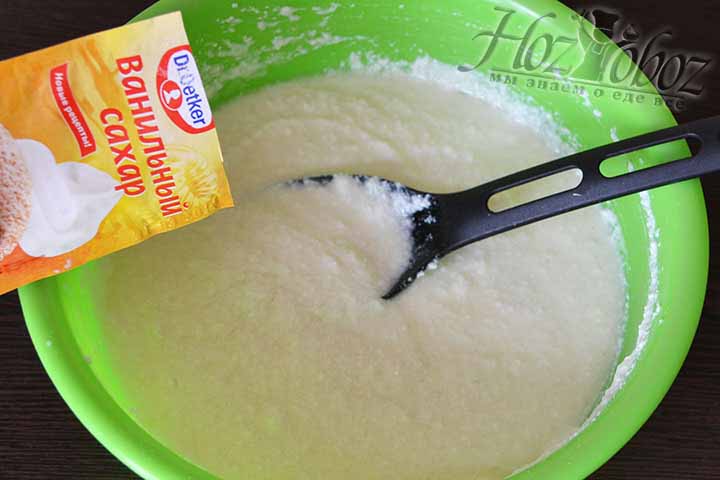
Lastly, add vanilla sugar to the curd.
- Now comes the most crucial moment in the work - cutting the dough and forming cheesecakes with cottage cheese, the photos of which, for sure, you, dear readers, have long aroused your appetite and desire to repeat this wonderful recipe in your kitchen. We spread the bun on the cutting table and sprinkle with flour.
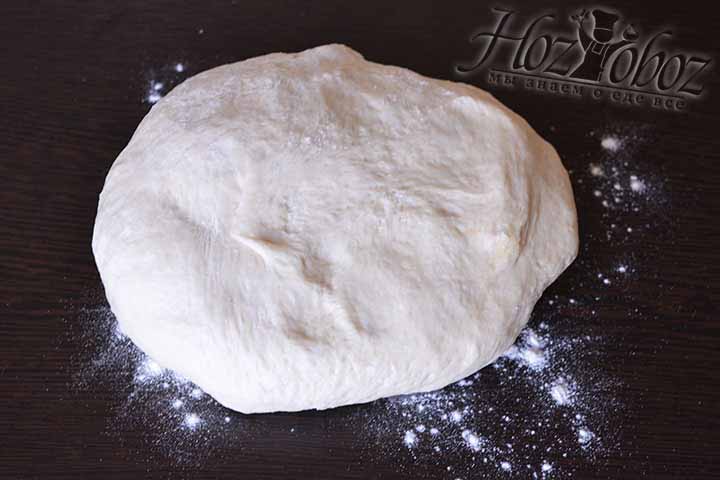
Place part of the dough on a floured table.
- We show two options for the formation of blanks for cheesecakes, and the choice will be yours. We divide the dough into two parts and roll one into a thick tourniquet.

Two types of blanks can be made for cheesecakes - choose the one that you like best.
- We cut it into equal pieces, which we roll into balls.

Cut the dough into small pieces and roll them into balls.
- This is the first way.
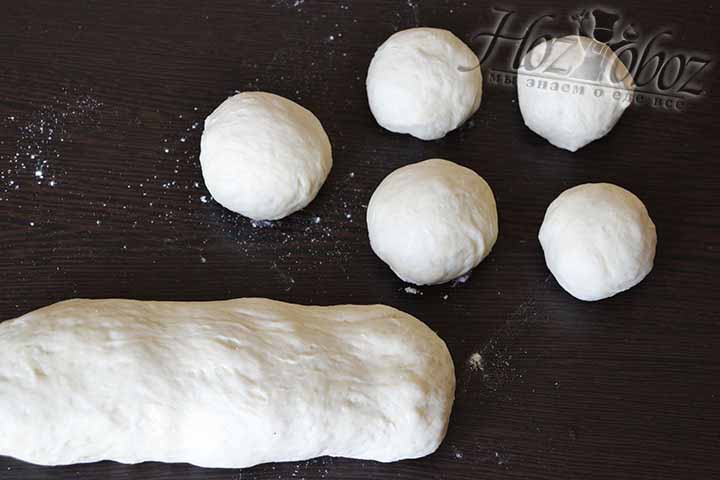
This is our number one option.
- The second option - we transform the dough for cheesecakes with cottage cheese into balls with the help of fingers, through which a part of the tourniquet is passed, as if into a ring.

In the second version, we squeeze out circles from a single piece of dough, as in the photo.
- We distribute the workpieces on a baking sheet sprinkled with oil and leave for proofing.
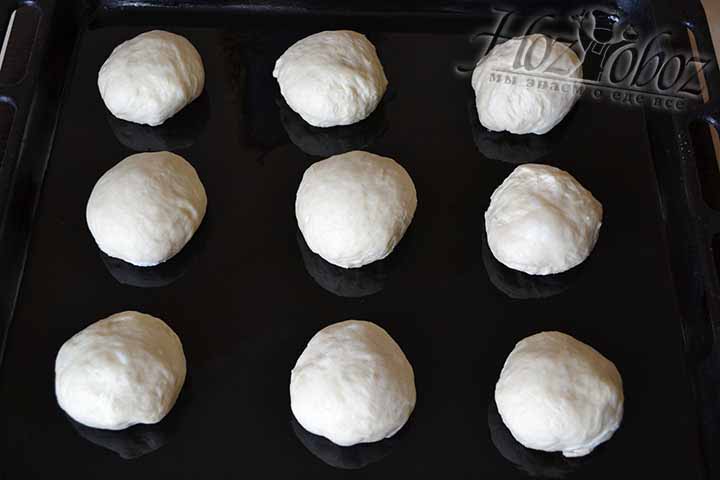
Lubricate the baking sheet with vegetable oil, lay out the finished koloboks on it and let them come up.
- In the center of each future cheesecake we make a recess with the help of improvised kitchen utensils - we have a wooden pusher, but it is not forbidden to use the bottom of the glass. The main thing is that the tool was dry and well sprinkled with flour.
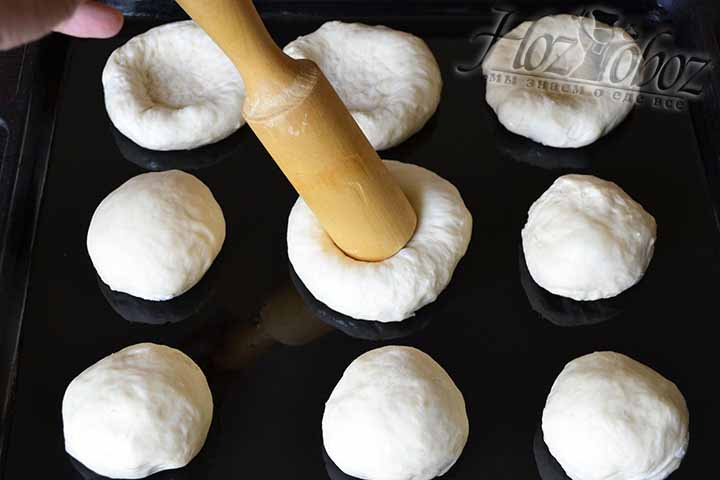
With the help of improvised means, we make a small depression in the cheesecake.
- The molds are ready - the dimples are well formed.
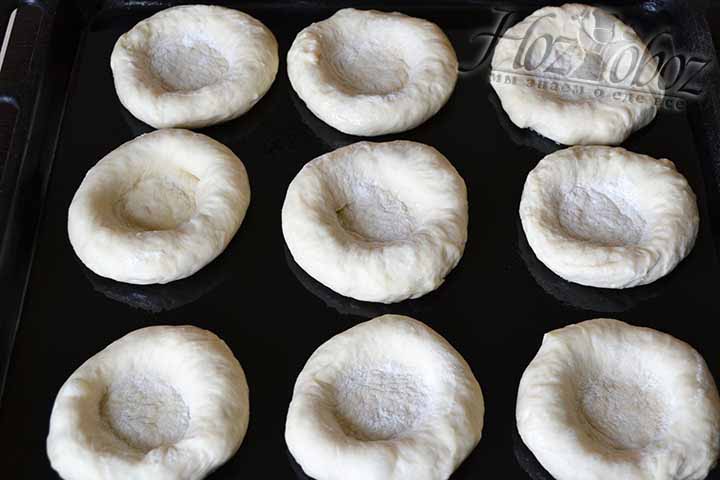
That's all - the place for the stuffing is ready.
- Gently coat them with egg yolk, trying not to get on a baking sheet.
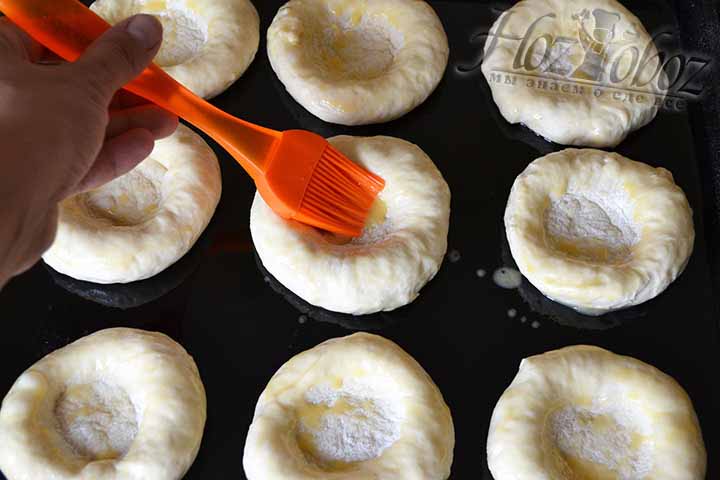
Now gently grease the buns with the egg yolk prepared in advance.
- We spread the stuffing in the size of a tablespoon in each cheesecake "cell" and do it, of course, very quickly, until it runs out.
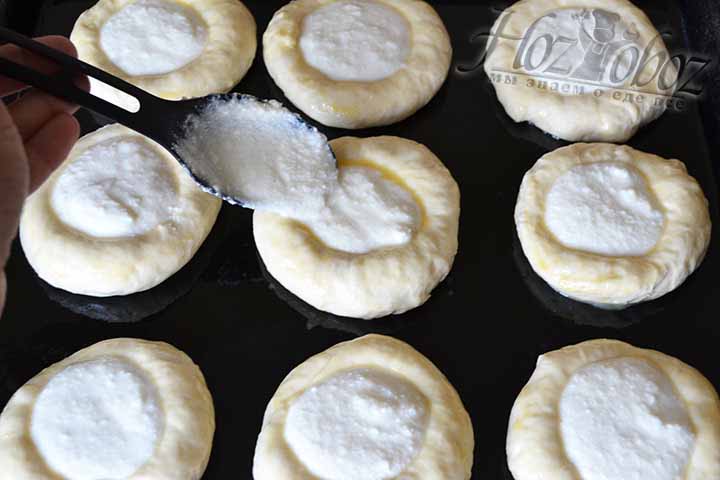
We fill each cheesecake with curd filling.
- We determine the baking sheet in a well-heated oven (200 °) for 30 minutes.

We bake buns at a temperature of 200 degrees for about 30 minutes.
- First, we determine the readiness of the cheesecakes by the characteristic aroma, golden color and splendor, and then grease with melted butter.

As soon as the cheesecakes acquire a characteristic golden hue, we take them out and grease them with melted butter.
- To give even more softness to the magnificent cheesecakes with cottage cheese, the recipe of which has come to an end, we soak the filling with oil, too, after placing our sunny pies on a dish.

By the way, in ready-made cheesecakes, you can pour oil over the filling - so the pies will be juicier.
The preparation of this dish can be carried out not only on yeast dough. Puff pastry with cottage cheese can cause appetite even for those who usually refuse baking due to various diets, and the royal puff pastry is able to outshine any idle pie.
The benefits of cheesecakes with cottage cheese
We would like to note that any tasty dish causes satiety and a lot of positive emotions in a hungry person - this is the biggest useful plus. In the old days in Russia, cheesecakes with cottage cheese, washed down with milk, had breakfast - and this rather modest meal was enough until the evening. The conclusion is this: cheesecakes with cottage cheese saturate the body with carbohydrates - this is a fact. Cottage cheese, as a source of calcium, is certainly useful too, but there is an opinion that it is not absorbed together with cereals, forming insoluble compounds. However, some part still enters the body, and it is definitely useful.
In conclusion, I would like to say that if there were no benefits in baking at all, as some nutritionists are trying to convey to us through the media, would our grandparents, who ate cheesecakes with cottage cheese instead of sweets, live so long. Our cheesecake with cottage cheese in the oven, although it differs slightly in taste from those primordially Russian open pies with cheese, but this does not stop it from being called Russian cheesecake, which has long won popular love. If you are still reading this recipe, it means that cheesecake with cottage cheese has conquered you too. Prepare a dish and be delighted!





